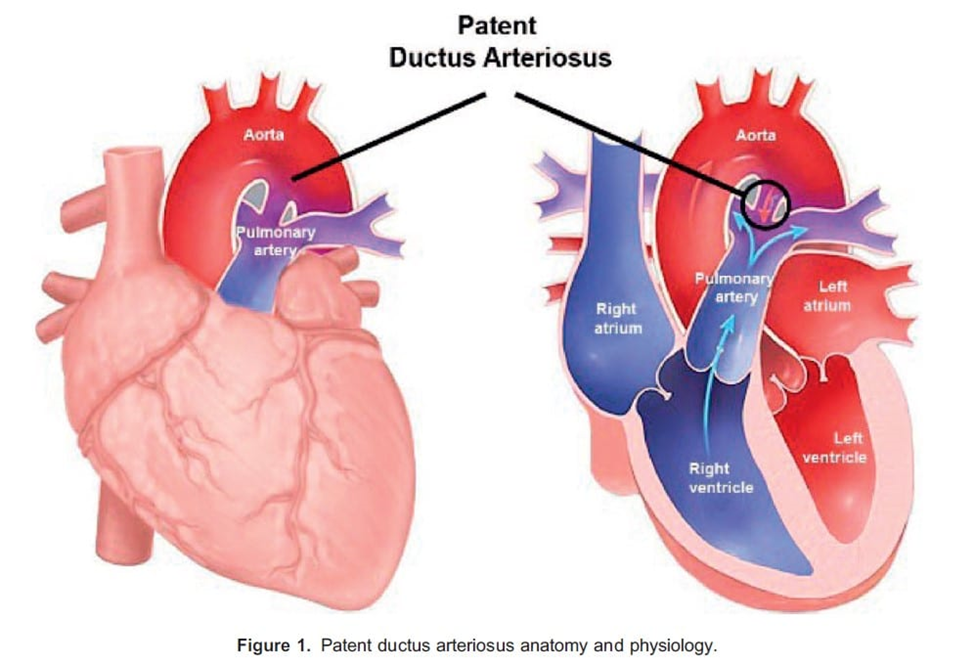A nurse is assessing a child who has a congenital heart defect. The nurse should recognize that which of the following defects is associated with increased pulmonary blood flow?
Coarctation of the aorta
Patent ductus arteriosus
Tetralogy of Fallot
Tricuspid atresia
The Correct Answer is B
A. Coarctation of the aorta
Coarctation of the aorta involves a narrowing of the aorta, leading to decreased blood flow to the lower body. It is not associated with increased pulmonary blood flow.
B. Patent ductus arteriosus
Patent ductus arteriosus (PDA) is a congenital heart defect where the ductus arteriosus, a fetal blood vessel that usually closes shortly after birth, remains open. This allows blood to flow from the aorta into the pulmonary artery, increasing pulmonary blood flow. Therefore, option B is correct.
C. Tetralogy of Fallot
Tetralogy of Fallot is a congenital heart defect characterized by four abnormalities, including a ventricular septal defect (VSD), pulmonary stenosis, right ventricular hypertrophy, and an overriding aorta. While it can lead to cyanosis due to right-to-left shunting, it is not primarily associated with increased pulmonary blood flow.
D. Tricuspid atresia
Tricuspid atresia involves the absence of the tricuspid valve, leading to a lack of direct blood flow from the right atrium to the right ventricle. It usually presents with decreased pulmonary blood flow rather than increased pulmonary blood flow.

Nursing Test Bank
Naxlex Comprehensive Predictor Exams
Related Questions
Correct Answer is A
Explanation
A. Droplet:
Pertussis is primarily transmitted through respiratory droplets when an infected person coughs or sneezes. Droplet precautions involve placing the child in a private room or with another child with the same infection. Healthcare workers should wear a mask or respirator when entering the room to protect against droplet transmission.
B. Contact:
Contact precautions are used for infections that can be spread by direct or indirect contact with the patient or their environment. Pertussis is not typically spread through contact with contaminated surfaces or objects.
C. Airborne:
Airborne precautions are used for infections that are transmitted through small droplet nuclei that remain in the air for long periods. Pertussis is primarily transmitted through larger respiratory droplets rather than tiny airborne particles.
D. Protective environment:
Protective environment precautions are used for patients who have weakened immune systems, such as those undergoing bone marrow transplants. These precautions are not applicable for a child with pertussis.

Correct Answer is B
Explanation
A. The infant does not exhibit fear of strangers.
The infant does not exhibit fear of strangers is not a finding that the nurse should report to the provider, as this is a normal social behavior for a 6-month-old infant. Infants usually develop stranger anxiety between 8 and 12 months of age, when they become more aware of their surroundings and attachment figures.
B. The infant does not roll over from his abdomen to his back.
By 6 months of age, most infants can roll over in both directions— from their abdomen to their back and vice versa. The inability to roll over from abdomen to back may indicate a delay in gross motor skills development. This finding should be reported to the healthcare provider for further evaluation.
C. The infant does not pick up objects from the floor with his fingers.
By 6 months of age, infants typically begin to develop the ability to grasp and pick up objects using their fingers. This milestone is part of fine motor skills development. The inability to pick up objects from the floor with fingers may indicate a delay in fine motor skills and should be reported to the provider for further assessment.
D. The infant does not sit on the floor unsupported.
By 6 months of age, infants typically begin to develop the ability to sit unsupported for short periods. While some variability exists in when infants achieve this milestone, the inability to sit unsupported at 6 months may indicate a delay in gross motor skills development. This finding should be reported to the provider for further evaluation.
Whether you are a student looking to ace your exams or a practicing nurse seeking to enhance your expertise , our nursing education contents will empower you with the confidence and competence to make a difference in the lives of patients and become a respected leader in the healthcare field.
Visit Naxlex, invest in your future and unlock endless possibilities with our unparalleled nursing education contents today
Report Wrong Answer on the Current Question
Do you disagree with the answer? If yes, what is your expected answer? Explain.
Kindly be descriptive with the issue you are facing.
